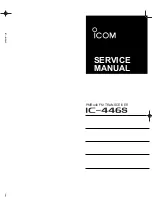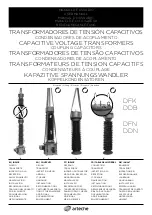
RECEIVER
Sensitivity
AM: 1.0
µ
V for 10 dB (S+N)/N at greater
than ½ -watt of audio output.
FM: 1.0
µ
V for 20 dB (S+N)/N at greater
than ½-watt of audio output.
Selectivity
AM/FM: 6 dB @ 3 KHz, 50 dB @ 9 KHz.
Image Rejection
More than 65 dB.
IF Frequency
AM/FM: 10.695 MHz 1
st
IF, 455 KHz 2
nd
IF
Adjacent-Channel
Rejection
60 dB AM
RF Gain Control
45 dB adjustable for optimum signal
reception.
Automatic Gain
Control (AGC)
Less than 10 dB change in audio output for
inputs from 10 to 100,000 microvolts.
Squelch
Adjustable; threshold less than 0.5
µ
V.
ANL
Switchable
Noise Blanker
RF type
Audio Output Power
4 watts into 8 ohms.
Frequency Response
300 to 2800 Hz.
Built-in Speaker
8 ohms, round.
External Speaker (Not
Supplied)
8 ohms; disables internal speaker when
connected.
Installation
LOCATION
Plan the location of the transceiver and microphone bracket before
starting the installation. Select a location that is convenient for operation and
does not interfere with the driver or passengers in the vehicles. In
automobiles, the transceiver is usually mounted below the dash panel, with
the microphone bracket beside it.
MOUNTING THE RADIO
Your transceiver is supplied with a universal mounting bracket. When
mounting the bracket and radio to your car, make sure it is mechanically
strong. Also provide a good electrical connection to the chassis of the
vehicle. Proceed as follows to mount the transceiver:
1. After you have determined the most convenient location in your vehicle,
hold the transceiver with mounting bracket in the exact location desired.
If nothing will interfere with mounting it in the desired position, remove
the mounting bolts. Before drilling the holes, make sure nothing will
interfere with the installation of the mounting bolts.
2. Connect the antenna cable plug to the standard receptacle on the rear
panel. Most antennas are terminated with a type PL-259 plug and mate
with the receptacle.
3. Connect the red DC power input wire (with the fuse) to +13.8V DC.
This wire extends from the rear panel. In automobile installation,
+13.8V DC is usually obtained from the accessory contact on the
ignition switch. This prevents the set being left on accidentally when the
driver leaves the car and also permits operating the unit without the
engine running. Locate the accessory contact on most ignition switches
by tracing the power wire from the AM broadcast receiver in the car.
4. Connect the black lead to ground. This is usually the chassis of the car.
Any convenient location with good electrical contact (remove paint) may
be used.
5. Mount the microphone bracket on the right side of the transceiver or
near the transceiver, using two screws supplied. When mounting in an
automobile, place the bracket under the dash so the microphone is
readily accessible.
- 3 -
- 4 -




























